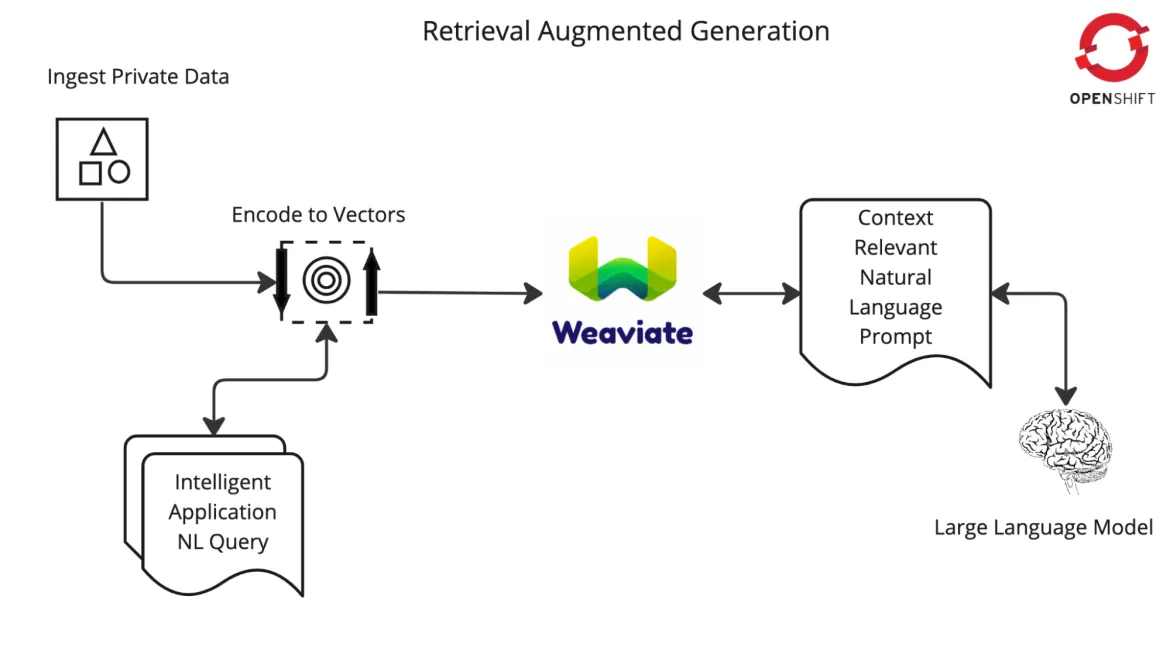In the field of artificial intelligence (AI) and machine learning (ML), the goal is to generate applications that give human-like responses to human interaction. One promising approach to achieving this is retrieval-augmented generation (RAG), which combines the strengths of existing methods (specifically, retrieval and generation-based models) to produce accurate and contextually relevant output from a large language model (LLM). This allows an organization’s private data sources to drive the behavior and performance of an LLM as real-time data becomes available. Leveraging the capabilities of Weaviate, an open source, cloud-native vector database, in conjunction with Red Hat OpenShift, your organization can harness the power of a RAG workflow to improve the quality of your products and customer experiences.
Understanding the retrieval-augmented generation workflow
A retrieval-augmented generation workflow begins by ingesting a pre-existing private knowledge base, typically in the form of unstructured data, into Weaviate. An embeddings model is used to encode the private data into vectors before it is stored in the database. Application queries written in a natural language must also be encoded before performing a similarity search using Weaviate’s SDK. This is all necessary to prepare a context relevant prompt which is then used to perform a generative search using an LLM.

This hybrid approach enhances the quality of generated outputs, grounds them contextually and keeps them aligned with the user's intent. The RAG workflow is appealing to enterprises and allows organizations to take advantage of the power of generative AI while their confidential data sources remain confidential. Additionally, this path avoids retraining or fine-tuning an LLM, a time consuming and often cost prohibitive process.
Features of Weaviate
At the heart of the retrieval-augmented generation workflow lies Weaviate, an open source vector database specializing in understanding and connecting heterogeneous data through semantic relationships. Weaviate's ability to organize data into spatial relationships enables it to capture complex connections between entities, making it an ideal foundation for building intelligent applications that require contextual understanding and semantic relevance.
Key features of Weaviate include:
- Built-in hybrid search: Merge different search algorithms and re-rank the results accordingly
- Fast advanced filtering: Apply complex filters across large datasets in milliseconds
- Native multi-tenancy and Scalability: Weaviate's cloud-native design allows for horizontal scaling and efficient resource consumption, allowing it to handle large volumes of data and user requests easily
- Configurable backups: Back up as often as you need, with zero downtime
- Vector index compression: Improve the memory footprint of large datasets
Key features of Red Hat OpenShift
To deploy and manage intelligent applications built on Weaviate, you can leverage Red Hat OpenShift, the industry’s leading hybrid cloud application platform powered by Kubernetes, that provides a more consistent environment with stronger security features for developing, deploying, and scaling containerized AI workloads.
- Container orchestration: OpenShift simplifies the deployment and management of containerized applications and provides a robust platform to support Weaviate’s distributed architecture options, including replication and sharding for high availability and throughput
- Developer experience: OpenShift offers a more seamless developer experience with integrated CI/CD pipelines, GitOps workflows, and developer tools, enabling rapid iteration and innovation. Developers can take advantage of Weaviate’s robust SDKs that combine semantic and generative search queries needed for creating RAG applications
- Security and compliance: OpenShift includes built-in features such as pod security policies, network policies, and encryption, providing confidence that applications deployed on the platform have an enhanced security posture and are compliant with industry regulations
- Accelerated computing: OpenShift supports hardware acceleration provided by the latest GPUs and advanced CPU SIMD instructions. Weaviate uses these features to speed up distance calculations, allowing your applications to run at peak performance
Use cases for Weaviate and Red Hat OpenShift
By combining Weaviate's and Red Hat OpenShift capabilities, organizations can build powerful applications that leverage the RAG workflow to deliver contextually relevant and intelligent responses to user queries. Whether it's developing virtual assistants, chatbots, recommendation systems, or knowledge management tools, the synergy between Weaviate and OpenShift enables organizations to unlock new possibilities in AI-driven application development.
Here are just a few common use cases for Weviate on OpenShift:
- Enterprise knowledge management: RAG can be a powerful tool for enterprise knowledge management, allowing organizations to efficiently organize, discover, and utilize internal knowledge resources
- E-commerce recommendation systems: By analyzing user behavior and product attributes within a vector database, RAG applications can drive personalized recommendations in e-commerce applications, enhancing the customer shopping experience
- Healthcare data integration: In the healthcare sector, RAG can facilitate the integration of diverse healthcare data sources, enabling comprehensive patient insights and supporting clinical decision-making processes
Get started with an example
Want to learn more? I've assembled a simple RAG demonstration deployable on a modest OpenShift cluster (similar to the Developer Sandbox for Red Hat OpenShift). The example application ingests a small number of text files containing categories, questions, and answers into Weaviate. The Weaviate SDK handles the vector embeddings and generative search in just a few lines of Python code to complete the RAG application. The source code, sample data, and instructions are available at https://github.com/redhat-na-ssa/demo-ai-weaviate.
Leverage open source AI
The convergence of the RAG workflow with the capabilities of Weaviate and Red Hat OpenShift presents a significant opportunity for organizations to propel their AI-driven applications to new heights.
Whether optimizing enterprise knowledge management, enhancing recommender systems, or facilitating proprietary data integration, the harmony between Weaviate and OpenShift empowers organizations to unlock the full potential of AI-driven innovation, paving the way for a future where intelligent applications thrive.
저자 소개
Bob is a Principal Specialist Solution Architect at Red Hat who helps customers and business partners build best of breed data science solutions on enterprise Kubernetes platforms. He has a long standing career in software development with experience in a number of open source technologies including Linux, Kubernetes and AI/ML frameworks. Bob holds an MS in Information Technology and an MBA from the University of Maryland. In his spare time he enjoys studying jazz and classical guitar.
유사한 검색 결과
채널별 검색
오토메이션
기술, 팀, 인프라를 위한 IT 자동화 최신 동향
인공지능
고객이 어디서나 AI 워크로드를 실행할 수 있도록 지원하는 플랫폼 업데이트
오픈 하이브리드 클라우드
하이브리드 클라우드로 더욱 유연한 미래를 구축하는 방법을 알아보세요
보안
환경과 기술 전반에 걸쳐 리스크를 감소하는 방법에 대한 최신 정보
엣지 컴퓨팅
엣지에서의 운영을 단순화하는 플랫폼 업데이트
인프라
세계적으로 인정받은 기업용 Linux 플랫폼에 대한 최신 정보
애플리케이션
복잡한 애플리케이션에 대한 솔루션 더 보기
오리지널 쇼
엔터프라이즈 기술 분야의 제작자와 리더가 전하는 흥미로운 스토리
제품
- Red Hat Enterprise Linux
- Red Hat OpenShift Enterprise
- Red Hat Ansible Automation Platform
- 클라우드 서비스
- 모든 제품 보기
툴
체험, 구매 & 영업
커뮤니케이션
Red Hat 소개
Red Hat은 Linux, 클라우드, 컨테이너, 쿠버네티스 등을 포함한 글로벌 엔터프라이즈 오픈소스 솔루션 공급업체입니다. Red Hat은 코어 데이터센터에서 네트워크 엣지에 이르기까지 다양한 플랫폼과 환경에서 기업의 업무 편의성을 높여 주는 강화된 기능의 솔루션을 제공합니다.

